Rheem RHS18 Grain Compact Water Softener User Guide
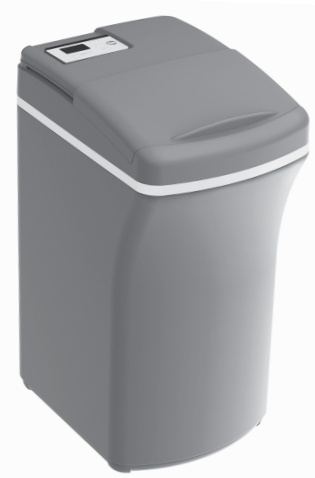
Before You Start
- The water softener requires a minimum water flow of 3 gallons per minute at the inlet. Maximum allowable inlet water pressure is 125 psi. If daytime pressure is over 80 psi, nighttime pressure may exceed the maximum. Use a pressure reducing valve if necessary (Adding a pressure reducing valve may reduce the flow). If your home is equipped with a back flow preventer, an expansion tank must be installed in accordance with local codes and laws.
- The water softener works on 24V DC electrical power, supplied by a direct plug-in power supply (included). Be sure to use the included power supply and plug it into a nominal 120V, 60 Hz household outlet that is in a dry location only, grounded and properly protected by an over current device such as a circuit breaker or fuse.
- Do not use this system to treat water that is micro-biologically unsafe or of unknown quality without adequate disinfection upstream or downstream of the system.
Packing List

Water Conditioning Information
IRON
Iron in water can cause stains on clothing and plumbing fixtures. It can negatively affect the taste of food, drinking water, and other beverages. Iron in water is measured in parts per million (ppm). The total* ppm of iron, and type or types*, is determined by chemical analysis. Four different types of iron in water are:
- Ferrous (clear water) iron
- Ferric (red water) iron
- Bacterial and organically bound iron
- Colloidal and inorganically bound iron (ferrous or ferric)
Ferrous (clear water) iron is soluble and dissolves in water. This water softener will reduce moderate amounts of this type of iron (see specifications).** Ferrous (clear water) iron is usually detected by taking a sample of water in a clear bottle or glass. Immediately after taking, the sample is clear. As the water sample stands, it gradually clouds and turns slightly yellow or brown as air oxidizes the iron. This usually occurs in 15 to 30 minutes. When using the softener to reduce Ferrous (clear water) iron, add 5 grains to the hardness setting for every 1 ppm of Ferrous (clear water) iron. See “Set Water Hardness Number” section.Ferric (red water), and bacterial and organically bound
irons are insoluble. This water softener will not remove ferric or bacterial iron.
SEDIMENT
Sediment is fine, foreign material particles suspended in water. This water softener will not remove sediment. This material is most often clay or silt. Extreme amounts of sediment may give the water a cloudy appearance. A sediment filter installed upstream of the water softener normally corrects this situation.
- Water may contain one or more of the four types of iron and any combination of these. Total iron is the sum of the contents.
- Capacity to reduce clear water iron is substantiated by laboratory test data
Installation Requirements
LOCATION REQUIREMENTS
- Do not locate the water softener where freezing temperatures occur. Do not attempt to treat water over 120ºF. Freezing temperatures or hot water damage voids the warranty.
- To condition all water in the home, install the water softener close to the water supply inlet, and upstream of all other plumbing connections, except outside water pipes. Outside faucets should remain on hard water to avoid wasting conditioned water and salt.
- A nearby drain is needed to carry away regeneration discharge (drain) water. Use a floor drain, laundry tub, sump, standpipe, or other options (check your local codes). See “Air Gap Requirements” and “Valve Drain Requirements” sections.
- The water softener works on 24V DC electrical power, supplied by a direct plug-in power supply (included). Provide nearby a 120V, 60 Hz electrical outlet in accordance with NEC and local codes.
- Always install the water softener between the water inlet and water heater. Any other installed water conditioning equipment should be installed between the water inlet and water softener (See Figure 4 below).
PLUMBING CODES
All plumbing must be completed in accordance with national, state and local plumbing codes.
AIR GAP REQUIREMENTS
A drain is needed for the water discharged from the valve during the softener’s regeneration cycle (See Figure 3). A floor drain, close to the water softener, is preferred. A laundry tub, standpipe, etc. are other drain options. Secure valve drain hose in place. Leave an air gap of 1-1/2” between the end of the hose and the drain. This gap is needed to prevent back flow of sewer water into the water softener. Do not put the end of the drain hose into the drain.
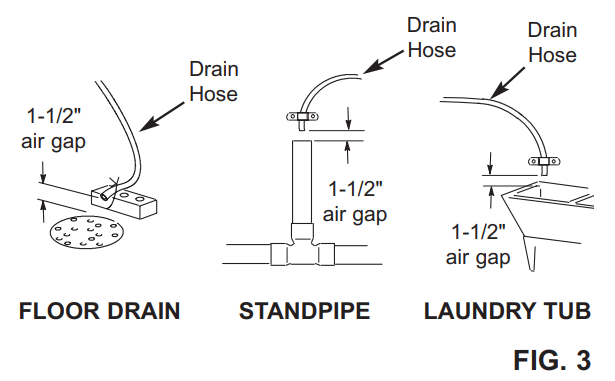
THE PROPER ORDER TO INSTALL WATER TREATMENT EQUIPMENT
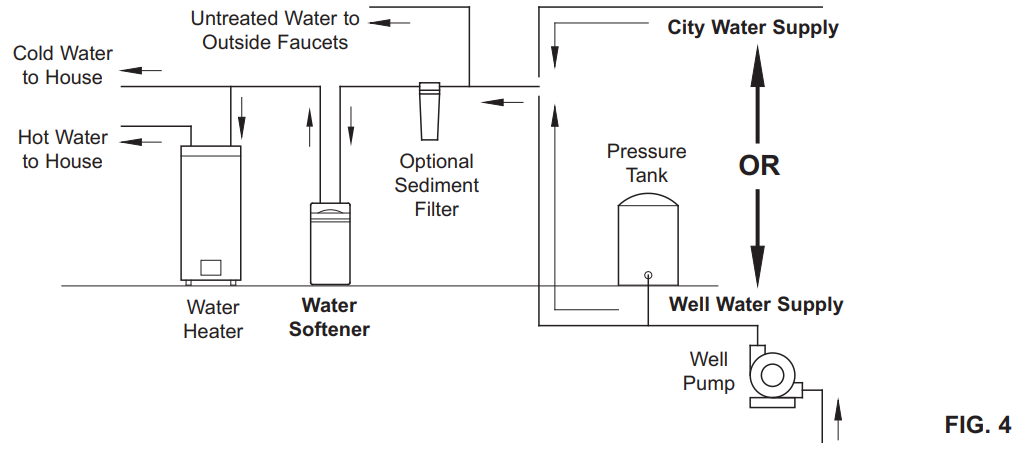
VALVE DRAIN REQUIREMENTS
Using the flexible drain hose (included), measure and cut to the length needed. Flexible drain hose is not allowed in all localities (check your plumbing codes). If local codes do not allow use of a flexible drain hose, a rigid valve drain run must be used. Purchase a compression fitting (1/4 NPT x 1/2 in. minimum tube) and 1/2″ tubing from your local hardware store. Plumb a rigid drain as needed (See Figure 6).

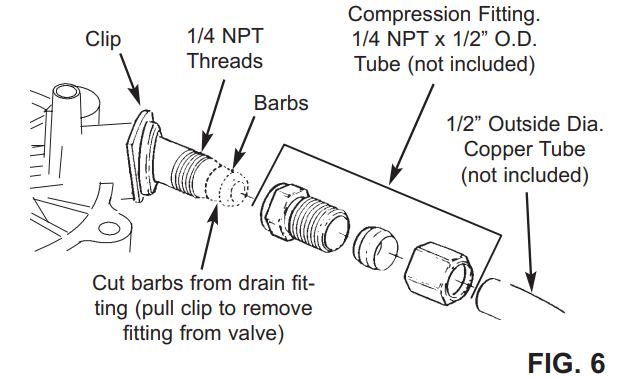
INLET / OUTLET PLUMBING OPTIONS
Always install either a single bypass valve (provided), as shown in Figure 7, or, if desired, parts for a 3 valve bypass system (not included) can be purchased and assembled, as shown in Figure 8. Bypass valves allow you to turn off water to the softener for maintenance if needed, but still have water in house pipes. Use:
- Copper pipe
- Threaded pipe
- PEX (Cross linked Polyethylene) pipe
- CPVC plastic pipe
- Other pipe approved for use with potable water
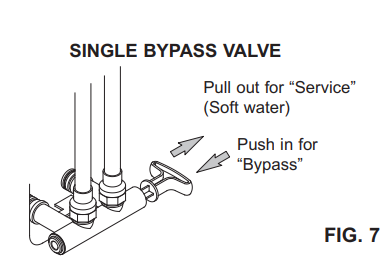
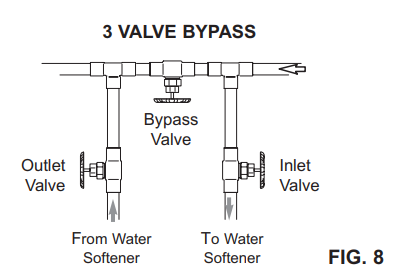
Installation Instructions
TYPICAL INSTALLATION
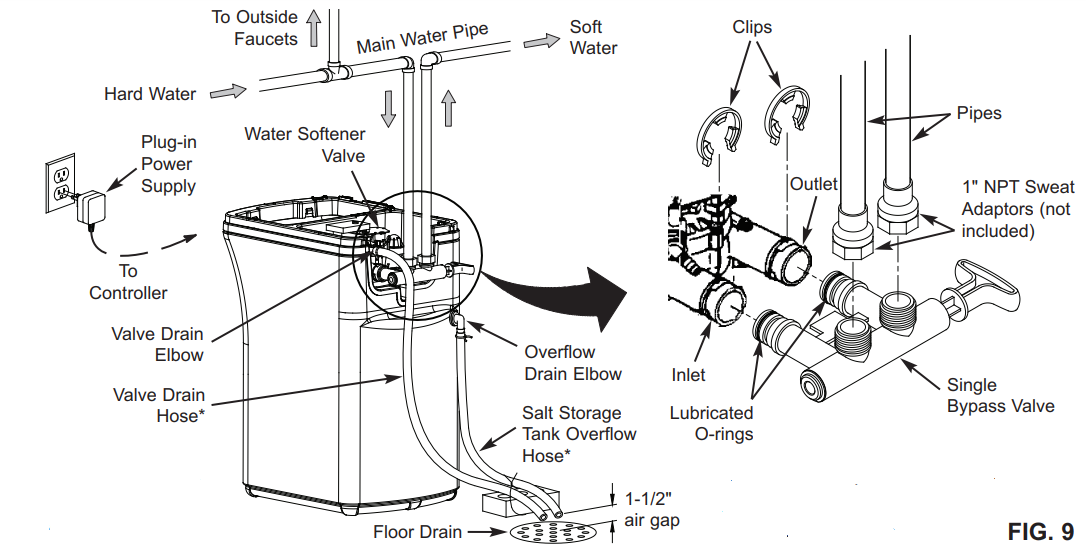
TURN OFF WATER SUPPLY
- Close the main water supply valve, located near the well pump or water meter.
- Shut off the electric or fuel supply to the water heater.
- Open all faucets to drain all water from house pipes.
NOTE: Be sure not to drain water from the water heater, as damage to the water heater elements could result.
ASSEMBLY
- Rheem® models are factory assembled. During installation, unsnap and remove the top cover, together with the salt lid, to expose the softener valve assembly. Set them aside to prevent damage. Check the brinewell to be sure it is secured and vertical (See Figure 11).
- Install the brine tank overflow grommet and elbow into the 13/16” diameter hole in the back of the salt storage tank wall.
MOVE THE UNIT INTO PLACE
- Move the water softener into the desired location. Set it on a solid, level surface.
IMPORTANT: Do not place shims directly under the salt storage tank to level the softener. The weight of the tank, when full of water and salt, may cause the tank to fracture at the shim.
- Visually check and remove any debris from the water softener valve inlet and outlet ports. Carefully remove the two large plastic clips (you will use them).
- Make sure the turbine assembly spins freely in the “out” port of the valve (See Figure 10).
- If not already done, put a light coating of silicone grease on the single bypass valve o-rings.
- Push the single bypass valve into the softener valve as far as it will go. Snap the two large holding clips into place, from the top down as shown in Figures 12 & 13.
IMPORTANT: Be sure the clips snap firmly into place so the single bypass valve will not pull out.
COMPLETE INLET AND OUTLET PLUMBING
Measure, cut, and loosely assemble pipe and fittings from the main water pipe to the inlet and outlet ports of the water softener valve. Be sure to keep fittings fully together, and pipes squared and straight. Be sure hard water supply pipe goes to the water softener valve inlet side.
NOTE: Inlet and outlet are marked on the water softener valve. Trace the water flow direction to be sure hard water is to inlet.
IMPORTANT: Be sure to fit, align and support all plumbing to prevent putting stress on the water softener valve inlet and outlet. Undue stress from misaligned or unsupported plumbing may cause damage to the valve. Complete the inlet and outlet plumbing for the type of pipes you will be using.

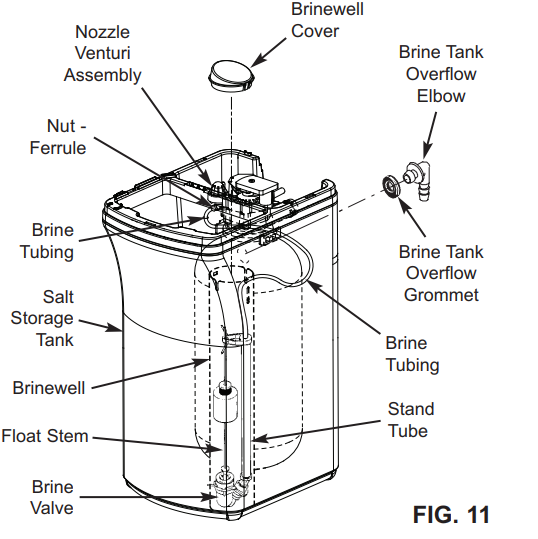
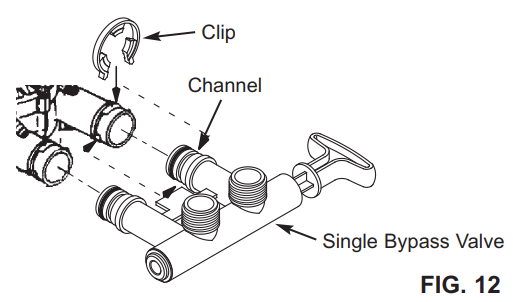
ADD WATER AND SALT TO THE SALT STORAGE TANK
- Using a container, add about three gallons of clean water into the salt storage tank.
- Add salt to the storage tank. Use nugget, pellet or coarse solar salts with less than 1% impurities.
PLUG IN THE POWER SUPPLY
During installation, the water softener wiring may be moved or jostled from place. Be sure all lead wire connectors are secure on the back of the electronic board and be sure all wiring is away from the valve gear and motor area, which rotates during re-generations.
- Plug the water softener’s power supply into an electrical outlet that is not controlled by a switch and is approved by local codes.
RESTART THE WATER HEATER
- Turn on the electricity or fuel supply to the water heater and relight the pilot, if applicable.
NOTE: The water heater is filled with hard water and, as hot water is used, it refills with conditioned water. In a few days, the hot water will be fully conditioned. To have fully conditioned hot water immediately, wait until the initial recharge (previous step) is over. Then, drain the water heater (following instructions for water heater) until water runs cold.
Programming the Water Softener
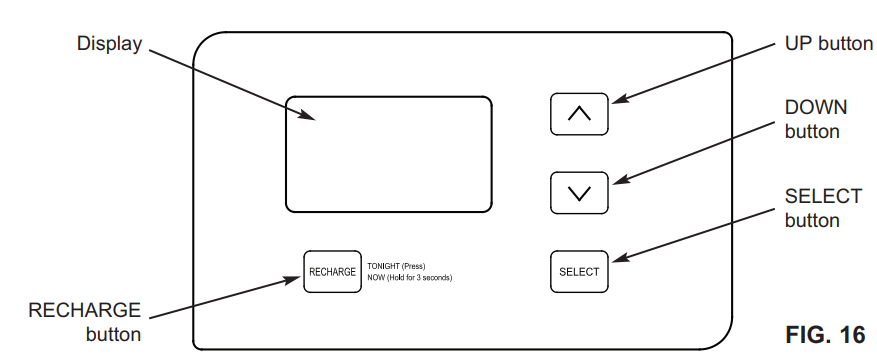
CLEAN REMINDER
The screen in Figure 17 appears, with “CLEAN” flashing in the display, when four months have elapsed on the system’s timer since start up or the last reset.
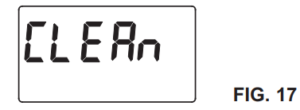
PROGRAM THE SOFTENER
When the power supply is plugged into the electrical outlet, the model code (LE18) and a software version number (example: J3.9), are briefly shown in the display. Then the words “PRESENT TIME” appear and 12:00 PM begins to flash.
Controller Features
EXTRA RECHARGE
Sometimes, a manually initiated recharge (regeneration) may be desired, or needed. Two examples are:
- You have used more water than usual (guests visiting) and you may run out of soft water before the next automatic regeneration.
- You did not add salt to the softener before it ran out. Add salt to the softener before regenerating. You can start a regeneration immediately, or you can set the controller to regenerate at the next preset recharge time (2:00 AM, or as set).
RECHARGE NOW
Press the RECHARGE button and hold for 3 seconds, until the words “RECHARGE NOW” begin to flash in the display. The softener enters the fill cycle of regeneration immediately. This regeneration will take about 2 hours to complete. Then, you will have soft water again.
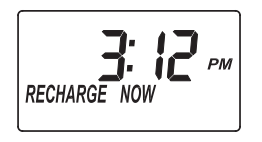
Routine Maintenance
ADDING SALT
Lift the salt lid and check the salt storage level frequently. If the water softener uses all the salts before you refill it, you will experience hard water. Until you have established a refilling routine, check the salt every two or three weeks. Always add if less than 1/4 full. Be sure the brine well cover is on.
NOTE: In humid areas, it is best to keep the salt storage level lower, and to refill more often to avoid salt “bridging”.
- Recommended Salt: Nugget, pellet or coarse solar salts with less than 1% impurities.
- Salt Not Recommended: Rock salt, high in impurities, block, granulated, table, ice melting, ice cream
making salts, etc
PROGRAM MEMORY
If electrical power to the softener goes off, the time display is blank but the electronic controller keeps the correct time for several hours. When electrical power comes on again, you will have to reset the present time only if the display is flashing.
BREAKING A SALT BRIDGE
Sometimes, a hard crust or salt “bridge” forms in the brine tank. It is usually caused by high humidity or the wrong kind of salt. When the salt “bridges,” an empty space forms between the water and the salt. Then, salt will not dissolve in the water to make brine. Without brine, the resin bed is not recharged and hard water will result. If the storage tank is full of salt, it is difficult to tell if you have a salt bridge. A bridge may be underneath loose salt. Take a broom handle, or like tool, and hold it next to the water softener. Measure the distance from the floor to the rim of the water softener. Then, carefully push the broom handle straight down into the salt. If a hard object is felt before the pencil mark is even with the top, it is most likely a salt bridge. Carefully push into the bridge in several places to break it. Do not use any sharp or pointed objects as you may puncture the brine tank.
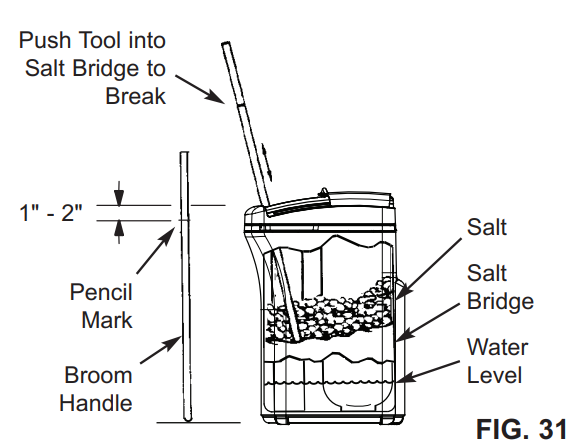
PROTECT THE WATER SOFTENER FROM FREEZING
If the softener is installed where it could freeze (summer cabin, lake home, etc.), you must drain all water
from it to stop possible freeze damage. To drain the softener:
- Close the shut-off valve on the house main water pipe, near the water meter or pressure tank.
- Open a faucet in the soft water pipes to vent pressure in the softener.
- Move the stem in the single bypass valve to bypass. Close the inlet and outlet valve in a 3 valve bypass system, and open the bypass valve. If you want water in the house pipes again, reopen the shut-off valve on the main water pipe.
- Unplug the power supply at the wall outlet. Remove the softener’s top cover, together with the salt lid. Take off both drain hoses if they will interfere with moving the softener into position over the drain.
- Carefully remove the large holding clips at the softener inlet and outlet. Separate the softener from the plastic installation adaptors, or from the bypass valve.
Dimensions
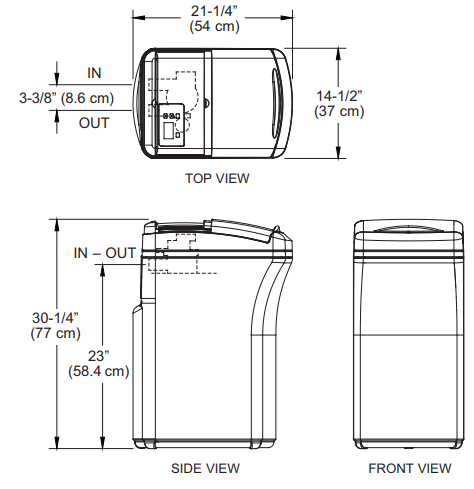
Specifications & Performance Claims
This model is efficiency rated. The efficiency rating is valid only at the minimum salt dose. This system has a demand initiated regeneration (D.I.R.) feature that complies with specific performance specifications intended to minimize the amount of regenerate brine and water used in their operation. This water softener has a rated softener efficiency of not less than 3,350 grains of total hardness exchange per pound of salt (based on sodium chloride) and shall not deliver more salt than its listed rating or be operated at a sustained maximum service flow rate greater than its listed rating. This system has been proven to deliver soft water for at least ten continuous minutes at the rated service flow rate. The rated salt efficiency is measured by laboratory tests described in NSF/ANSI Standard 44. These tests represent the maximum possible efficiency that the system can achieve. Operational efficiency is the actual efficiency after the system has been installed. It is typically less than the rated efficiency, due to individual application factors including water hardness, water usage, and other contaminants that reduce a softener’s capacity.
Troubleshooting Guide
| PROBLEM | CAUSE | CORRECTION |
| No soft water | 1. No salt in the storage tank. | Refill with salt and then use RECHARGE NOW feature. |
| No soft water & dis- play is blank | 1. Power supply unplugged at wall outlet, or power cable disconnected from back of elec- tronic board or power supply malfunction. | Check for loss of power and correct. Reset electronic controls and then use RECHARGE NOW feature. |
| 2. Fuse blown, circuit breaker popped, or cir- cuit switched off (See “Program Memory” on Page 15). | Replace fuse, reset circuit breaker, or switch circuit on, and then use RECHARGE NOW feature. | |
| 3. Electronic control board malfunction. | Replace electronic control board (See Page 21). | |
| No soft water & salt level not dropping | 1. Salt storage tank “bridged”. | Refer to “Breaking a Salt Bridge” section to break. |
| 2. Bypass valve(s) in “bypass” position. | Move bypass valve(s) to “service” position. | |
| No soft water & salt storage tank full of water, water running to drain while unit is in the soft water cycle | 1. Dirty, plugged or damaged nozzle & venturi assembly | Take apart, clean and inspect nozzle & venturi (See “Cleaning the Nozzle & Venturi” section. |
| 2. Inner valve fault causing leak. | Replace seals and rotor. | |
| 3. Valve drain hose is plugged. | Hose must not have any kinks, sharp bends or any water flow blockage (See “Valve Drain Requirements” section. | |
| 4. Valve drain line and Salt Storage Tank overflow drain connected together by a tee. | Disconnect tee and run separate drain lines. | |
| 5. Low or high system water pressure (low pressure may disrupt brine draw during recharge, high pressure may cause inner valve parts failure). | If pressure is low, increase well pump output to a mini- mum 20 psi. If daytime pressure is over 100 psi, add a pressure reducing valve in the supply pipe to the soften- er. Contact a licensed plumber. | |
| 6. Brine float dirty or broken. | Clean or replace Brine Valve Float Assembly. | |
| 7. Leak between valve and resin tank. | Replace o-rings between resin tank and valve. | |
| Water hard some- times | 1. Incorrect time set. | Check and change time setting. |
| 2. Incorrect water hardness set. | Refer to “Set Water Hardness” section to set correctly. | |
| 3. Incorrect model code programmed. | Refer to “Program the Water Softener” section to set cor- rectly. | |
| 4. Hot water being used when softener is regenerating. | Avoid using hot water while the softener is regenerating, as the water heater will fill with hard water. | |
| 5. Possible increase in water hardness. | Test untreated water for hardness and iron, and program the water softener accordingly (See “Set Water Hardness”) section to set. | |
| 6. Leaking faucet or toilet valve. Excessive water usage. | A small leak can waste hundreds of gallons of water in a few days. Fix all leaks and always fully close faucets. | |
| Iron in water | 1. Clear water iron in water supply. | Test untreated water for hardness and iron, and program the water softener accordingly (See “Set Water Hardness”) section to set. |
| 2. Iron in soft water. | Clean resin bed with Resin Bed Cleaner. Follow instruc- tions on package. | |
| 3. Bacterial or organic bound iron. | Cannot be treated by water softener. | |
| Resin in household plumbing | 1. Crack in distributor or riser tube. | Replace resin tank assembly. |
| Salt storage tank leaking | 1. Crack in brine tank. | Replace salt storage tank assembly. |
| Motor stalled or clicking | 1. Motor malfunction or internal valve fault causing high torque on motor. | a. Replace rotor/seal. b. Replace motor & switch. |
| Error code E1, E3 or E4 appears | 1. Fault in wiring harness or connections to position switch. | Replace wiring harness or connections to position switch. |
| 2. Fault in switch. | Replace switch. | |
| 3. Fault in valve causing high torque. | Replace rotor/seal. | |
| 4. Motor inoperative. | Replace motor. | |
| Error code E5 | 1. Electronic control malfunction. | Replace electronic control board. |
| Status light off, but display is not blank | 1. Status light dislodged from its holder. | Remove top cover and reinsert status light into its holder. |
REFERENCE LINK
https://www.rheem.com/rheem-preferred-series-water-softeners/



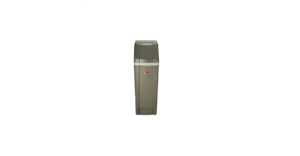
 Afrikaans
Afrikaans Albanian
Albanian Amharic
Amharic Arabic
Arabic Armenian
Armenian Azerbaijani
Azerbaijani Basque
Basque Belarusian
Belarusian Bengali
Bengali Bosnian
Bosnian Bulgarian
Bulgarian Catalan
Catalan Cebuano
Cebuano Chichewa
Chichewa Chinese (Simplified)
Chinese (Simplified) Chinese (Traditional)
Chinese (Traditional) Corsican
Corsican Croatian
Croatian Czech
Czech Danish
Danish Dutch
Dutch English
English Esperanto
Esperanto Estonian
Estonian Filipino
Filipino Finnish
Finnish French
French Frisian
Frisian Galician
Galician Georgian
Georgian German
German Greek
Greek Gujarati
Gujarati Haitian Creole
Haitian Creole Hausa
Hausa Hawaiian
Hawaiian Hebrew
Hebrew Hindi
Hindi Hmong
Hmong Hungarian
Hungarian Icelandic
Icelandic Igbo
Igbo Indonesian
Indonesian Irish
Irish Italian
Italian Japanese
Japanese Javanese
Javanese Kannada
Kannada Kazakh
Kazakh Khmer
Khmer Korean
Korean Kurdish (Kurmanji)
Kurdish (Kurmanji) Kyrgyz
Kyrgyz Lao
Lao Latin
Latin Latvian
Latvian Lithuanian
Lithuanian Luxembourgish
Luxembourgish Macedonian
Macedonian Malagasy
Malagasy Malay
Malay Malayalam
Malayalam Maltese
Maltese Maori
Maori Marathi
Marathi Mongolian
Mongolian Myanmar (Burmese)
Myanmar (Burmese) Nepali
Nepali Norwegian
Norwegian Pashto
Pashto Persian
Persian Polish
Polish Portuguese
Portuguese Punjabi
Punjabi Romanian
Romanian Russian
Russian Samoan
Samoan Scottish Gaelic
Scottish Gaelic Serbian
Serbian Sesotho
Sesotho Shona
Shona Sindhi
Sindhi Sinhala
Sinhala Slovak
Slovak Slovenian
Slovenian Somali
Somali Spanish
Spanish Sundanese
Sundanese Swahili
Swahili Swedish
Swedish Tajik
Tajik Tamil
Tamil Telugu
Telugu Thai
Thai Turkish
Turkish Ukrainian
Ukrainian Urdu
Urdu Uzbek
Uzbek Vietnamese
Vietnamese Welsh
Welsh Xhosa
Xhosa Yiddish
Yiddish Yoruba
Yoruba Zulu
Zulu